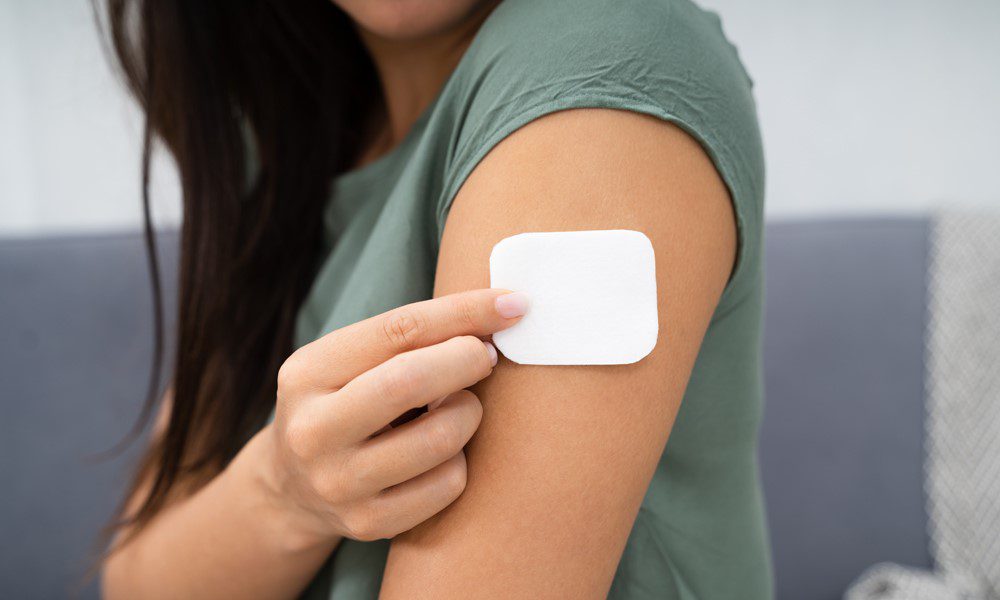CBD products absolutely exploded in popularity in recent years, and the market doesn’t show any signs of slowing down. In 2021, the CBD market is estimated at around $3.5 billion, but is expected to grow to nearly $13.4 billion by 2028. Because CBD is still relatively new, there is ample opportunity for manufacturers to introduce new products — like CBD adhesive patches — and gain significant market share. Manufacturing CBD patches requires a thoughtful approach that balances product performance needs and overall user experience. Here’s a quick introduction to help product developers create CBD patches quickly and efficiently.
Why manufacture CBD patches?
There are a lot of CBD products on the market: gummies, lotions, tinctures, vaporizers, oils and much more. So, why would consumers want CBD patches in particular? As it turns out, transdermal CBD patches offer a number of advantages over other products, including:
- Avoids the “First Pass Effect” where the body’s metabolism limits the effectiveness of oral drugs
- Consistent doses (compared to variable or hard-to-measure doses using CBD lotion or similar products)
- Feels more professional/medical
- Controlled and consistent release of CBD compounds
- Easy to apply and remove
Types of CBD patches
From a manufacturing perspective, there are two main types of CBD patches: matrix patches and pre-dosed patches.
Matrix patches – These patches are typically composed of five distinct layers (peel-off liner, matrix layer, separating layer, adhesive layer, backing layer) and start working instantly because the CBD is infused directly into the matrix layer that touches the skin.
Pre-dosed patches – The most common type of CBD patches on the market, these patches typically have fewer layers because the CBD is compounded into the adhesive and not infused into the patch itself. The CBD level is controlled and evenly distributed on the patch to release a steadier CBD delivery rate compared to the tapered release experienced with matrix patches. Also, the pre-dosed CBD patches are absorbed by the skin and avoid the “first pass effect” by not utilizing the GI tract.
The type of design used can impact product performance. So, engineers will need to think critically about product goals before choosing a specific type of patch. Many CBD patches are made with permeation enhancers to help CBD cut through skin’s natural defenses and reach the bloodstream. The strength of CBD patches can vary from 0.5mg up to 120mg or more.
Manufacturing challenges
Manufacturing CBD patches requires engineers to overcome many of the same challenges associated with other types of stick-to-skin products. Product developers need to consider the impact adhesives have on user comfort, how to ensure user mobility and how to design products that are as discreet as they are effective. Here are just some of the challenges that will need be addressed when designing and manufacturing CBD patches:
- Adhering patches to a dynamic surface like skin that has varying textures, elasticity and other factors that can impact product performance
- Achieving strong enough holding power to stay affixed during long wear-times, but still easy to remove with one hand without causing significant discomfort
- Managing moisture from sweat, water and natural oils without compromising adhesive performance
- Ensuring the product is “breathable” enough so it doesn’t damage skin
An experienced converter can help product developers choose the appropriate materials and adjust designs to craft effective CBD patches that users will want to wear.
For insights on how to bring stick-to-skin products to market quickly and efficiently, download our ebook, Designing and Producing Wearable Stick-to-Skin Products.
Tailoring products to user preferences
To create the perfect CBD patch, engineers need to fully understand who their customers are and why they are using these products in the first place. This can be challenging as CBD products have become so mainstream that they are commonly used by people across all demographics and for a variety of purposes. For instance, some athletes use CBD to aid in their recovery process, and many professionals use it to destress after a long day. What does this type of more casual use say about how these products should be designed? On the other hand, some people use CBD as part of their medical care, seeking to reduce seizures, provide pain relief and even assist in cancer treatment. What kind of design, packaging and materials considerations are most appropriate for these types of users? By considering these kinds of questions, product developers can create CBD patches that are perfectly tailored to user preference and needs.
Opportunity awaits
In a growing market with customers who are willing to try new things, CBD patches represent a tremendous opportunity for manufacturers. The key is figuring out how to create these innovative products quickly and on budget. By partnering with an experienced converter that can help design, develop and manufacture CBD patches, health and wellness brands can capture market share and position themselves for significant growth in the years ahead.
Have an idea for a new CBD product? The Tape Lab has the knowledge, experience and capabilities to bring your vision to life. Contact us to see how we can help you gain traction in the CBD market.
